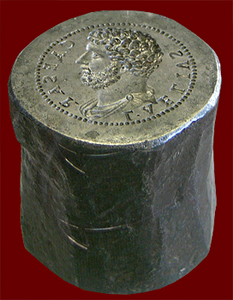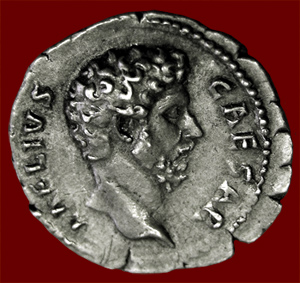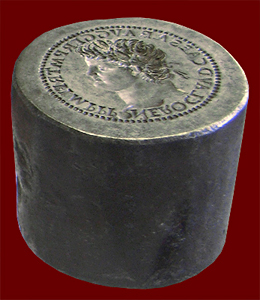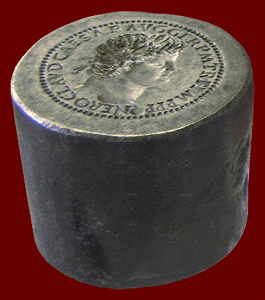
anvil die created by Giovanni Cavino
Bibliothèque Nationale

denarius of Aelius Caesar,
Museum of Cultural History,
University of Oslo

anvil die created by Giovanni Cavino Bibliothèque Nationale |
 denarius of Aelius Caesar, Museum of Cultural History, University of Oslo |
Very few ancient Roman coin dies have survived. After many strikings the dies eventually wore out, producing coins with lettering and designs that were less and less crisp, until the coins became unacceptable and the dies were discarded (probably destroyed). However, the Bibliothèque Nationale in Paris has a collection of dies made in imitation of the ancient Roman dies by a sixteenth-century engraver and medallist from Padua named Giovanni Cavino. Cavino used these dies to strike many sestertii that imitated ancient Roman coins in design and method of striking. Today the coins struck by Cavino, known as "Paduans," are collector's items in their own right, though scholars can distinguish them from genuine Roman coins because of slight differences in the metal alloy, the thickness of the coin, and the cut of the letters.
Cavino's dies can give us some idea of what the ancient Roman dies may have looked like. For example, the die shown above, an anvil die used to produce the obverse of a coin, has an incised (recessed and reversed) engraving of the portrait and lettering. The genuine Roman coin shown next to the die is a denarius of Hadrian with a portrait of Lucius Aelius Caesar, Hadrian's adopted son and designated heir who died suddenly in January of 138 CE while the emperor was still alive. The image below shows an anvil die of Cavino that imitates the sestertii of Nero; the image on the right has been flipped horizontally and has a genuine Roman sestertius of Nero superimposed on it.

|
 |